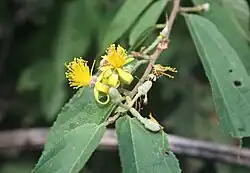Grewia flavescens
| Grewia flavescens | |
|---|---|

| |
| Flowering in autumn, South Africa | |

| |
| A he-goat browsing on G. flavescens | |
| Scientific classification | |
| Kingdom: | Plantae |
| Clade: | Tracheophytes |
| Clade: | Angiosperms |
| Clade: | Eudicots |
| Clade: | Rosids |
| Order: | Malvales |
| Family: | Malvaceae |
| Genus: | Grewia |
| Species: | G. flavescens
|
| Binomial name | |
| Grewia flavescens | |
| Synonyms[2] | |
|
List
| |
Grewia flavescens, called rough-leaved raisin, sandpaper raisin, and donkey berry (a name it shares with Grewia bicolor), is a species of flowering plant in the family Malvaceae, native to sub‑Saharan Africa, Yemen, Saudi Arabia, and India.[2] It is considered to be an underutilized crop, both for its fruit and its use for livestock forage.[3] Caterpillars of Anaphe reticulata have been found to feed on the foliage.[4]
Gallery
-
 Larger stems are characteristically angular
Larger stems are characteristically angular -
 Ripe fruit, winter
Ripe fruit, winter -
 Dry fruit, winter
Dry fruit, winter
References
- ^ Botanic Gardens Conservation International (BGCI).; IUCN SSC Global Tree Specialist Group (2020). "Grewia flavescens". IUCN Red List of Threatened Species. 2020: e.T146452936A146452938. doi:10.2305/IUCN.UK.2020-2.RLTS.T146452936A146452938.en. Retrieved 18 November 2021.
- ^ a b "Grewia flavescens Juss". Plants of the World Online. Board of Trustees of the Royal Botanic Gardens, Kew. Retrieved 27 May 2021.
- ^ Veeresh Kumar; Uthappa, A. R.; Srivastava, Madhulika; Vijay, D.; Kumaranag, K. M.; Manjunatha, N.; Rana, Maneet; Newaj, Ram; Handa, A. K.; Chaturvedi, O. P. (2017). "Floral biology of Grewia flavescens Juss.: An underutilized crop". Genetic Resources and Crop Evolution. 64 (7): 1789–1795. Bibcode:2017GRCEv..64.1789V. doi:10.1007/s10722-017-0536-y. S2CID 39388252.
- ^ Scholtz, Clarke H.; Holm, Erik (June 1982). "Trophic ecology of Lepidoptera larvae associated with wooded vegetation in a Savanna Ecosystem, Savanna Ecosystem Project (National Programme for Environmental Sciences, Nylsvley Study Area)" (PDF). South African National Scientific Reports (55): 19. Retrieved 27 May 2023.
